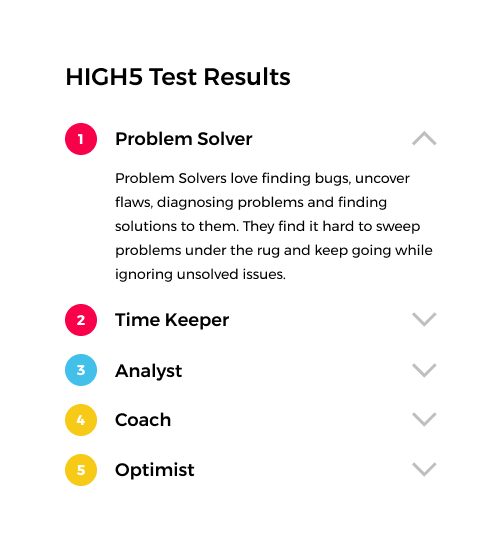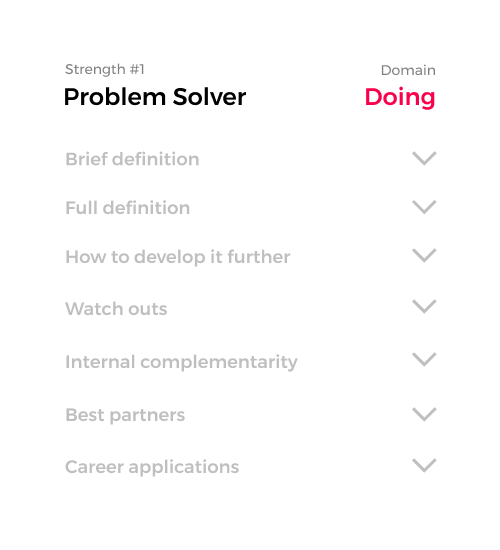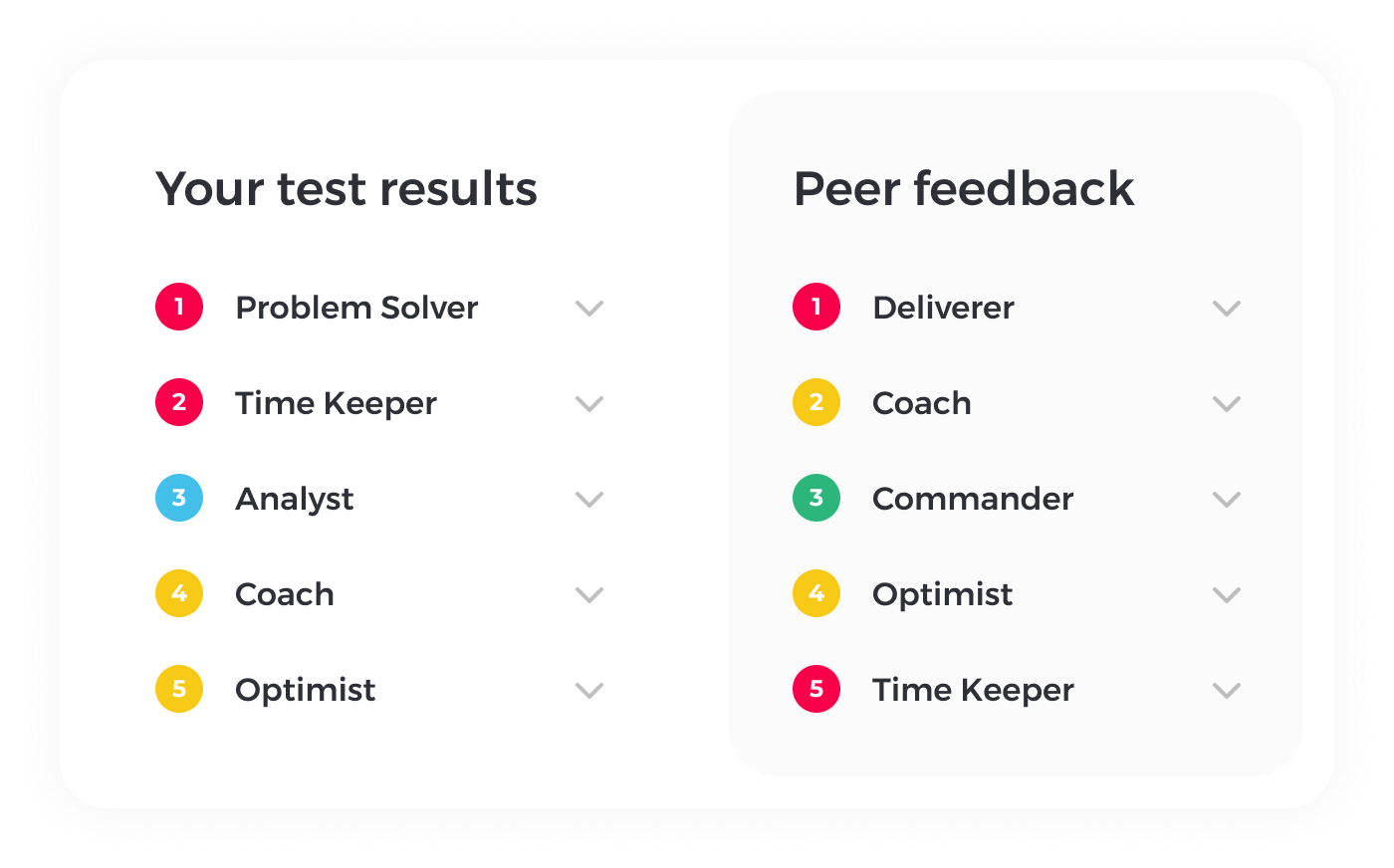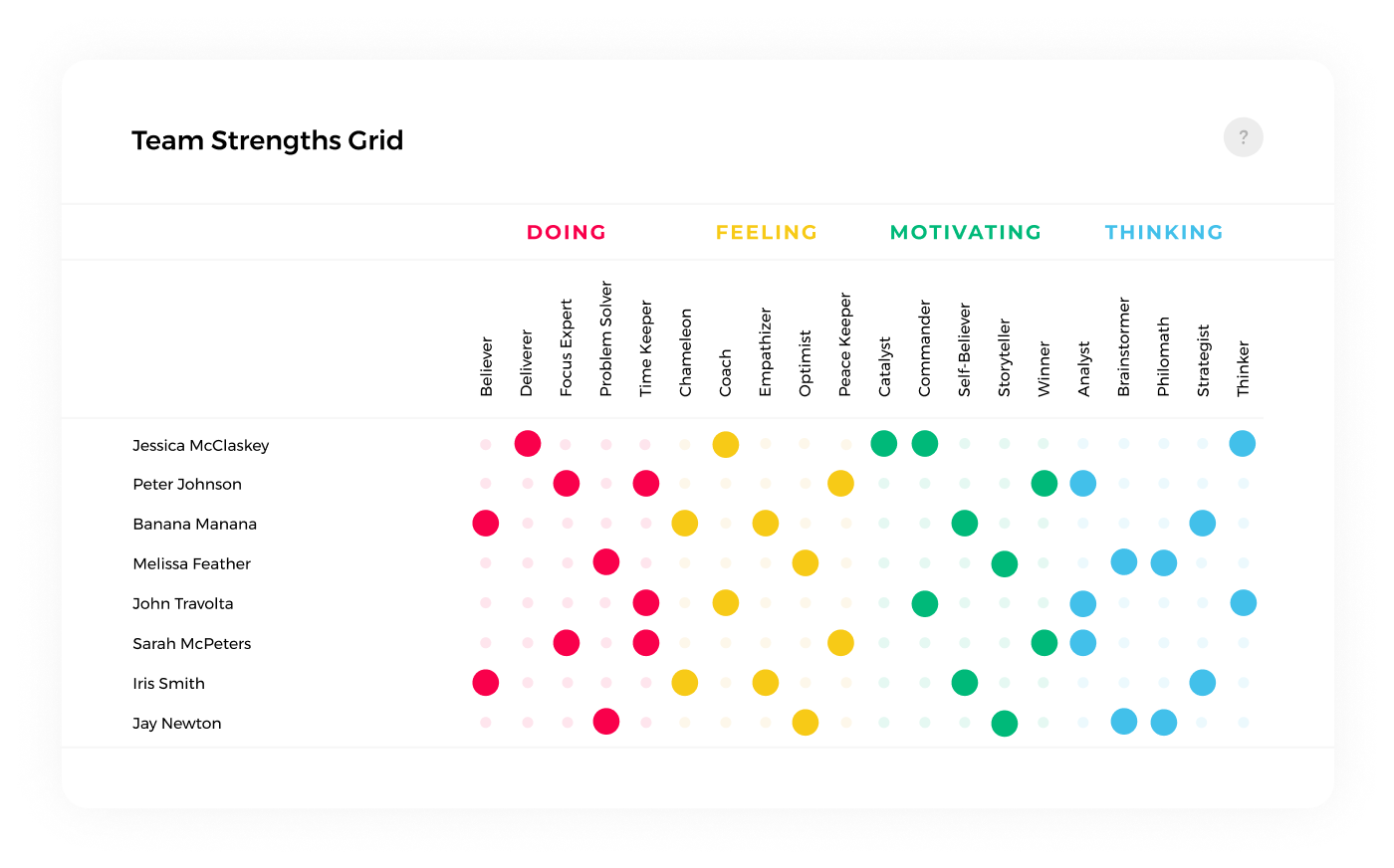CliftonStrengths (StrengthsFinder) Test: Free Online Alternative

HIGH5 is an intuitive platform designed to help any person discover what they are great at and to apply this knowledge towards goals that are meaningful to you

Your personalized results will give you an ‘aha’ moment displaying top 5 things you are particularly great at

Gain hands-on insights on what makes you unique and how to apply it for professional and personal success
This comparison is not exhaustive, but illustrative of key differences
HIGH5
CliftonStrengths
What it measures
Strengths
Talent themes
Assessment length
15min
45min
Assessment cost
Free
$24.99 USD
The most expensive report
$29 USD
$59.99 USD
Development insights
Blind spot insights
Career applications
Dedicated team report
Interpersonal reports
Interactive exercises
360-degree peer review
When we ask our clients why they choose HIGH5 over CliftonStrengths (formerly known as Gallup’s StrengthsFinder), they often mention the intuitive user experience, variety and depth of reports, and the interactive nature of the platform. Here are their favorite features:

Gain actionable insights into the strengths your peers value most, so you can focus on what you do best. This powerful tool not only boosts your confidence but also helps you strategically align your strengths with team goals, driving your success and advancing your career.

Compare your strengths with other people and discover shared and complementary qualities. These insights help you build stronger connections, leverage each other’s strengths, and achieve better results together. Elevate your partnerships and drive success with personalized, actionable feedback.

Get deep insights into the collective strengths of your team and how each member can collaborate more effectively. HIGH5 Team Report highlights key dynamics, uncovers complementary strengths, and provides actionable strategies to enhance teamwork. With a clear understanding of how to best work together, your team will achieve greater cohesion, productivity, and success.
In HIGH5, the strengths test is just the first step. The real positive change happens when you apply your results in practice. Our interactive platform offers a holistic answer to the “What’s next?” question.
Strengths Focused
Identifies strengths not talents or themes
Action Oriented
Designed to help you put your results into practice
Interpersonal Insights
Gives hands-on insights to work best with others
Team Strengths Analysis
Allows analyzing strengths of teams & organizations
Weekly Insights
Every week get fresh insights in your mailbox
Guided Exercises
Introspective activities that guide you to results
Easy Administration
Create a setup you need with multiple access rights
Blind Spots
Insights on how not to turn strengths into weaknesses
Clear & Intuitive
No need for someone to decode your results for you
Easily Scalable
Start by yourself and expand to entire company
Research-Backed
Based on the latest positive psychology research
Immediate Start
Complete self-service platform without waiting
Growth Tracking
Tracks how you progress in your personal development
360 Review
Get an external view on what you are great at
Strengths Academy
Continue to learn from hundreds of video courses
Cost Effective
Start free and upgrade anytime to what you need
Try the platform yourself or request a personalized demo tailored to your needs
What is the CliftonStrengths assessment (formerly StrengthsFinder Test)?
The CliftonStrengths assessment is an online talent assessment tool, offered by the Gallup Organization. The CliftonStrengths test is formerly known as the Clifton StrengthsFinder test.
The test is based on the research and findings of world-renowned psychologist Dr. Donald O. Clifton. Throughout the assessment, test takers will be asked a series of approximately 177 questions. The responses to these questions will correspond to different talents.
CliftonStrengths test asks a wide variety of queries. You may be asked to recall your prior successes, how you interact in the workplace, how others respond to your interactions, and many other topics. These questions tie into how you use strengths throughout your career and beyond.
The CliftonStrengths test assumes that you already have some work experience and are no longer a student. For a student-tailored test, consider taking CliftonStrengths for Students (formerly the StrengthsQuest) ,
The goal of taking the CliftonStrengths is to ultimately identify your talents and apply a strength-based approach to further development. The test results will provide you with an in-depth report and results on your abilities. Depending on the type of the CliftonStrengths report you purchase, you can either see insights on only your top 5 strengths or the entire report with 34 themes measured by the StrengthsFinder test.
Millions across the globe already trust the CliftonStrengths assessment. Some prefer to take the individual assessment at home, but many are required to take the test by their manager.
In either case, acknowledging your strengths has tremendous and long-lasting benefits. In this respect, HIGH5 can help you identify your strengths, not your talents. It is, therefore, important to note that HIGH5 is not a substitution for CliftonStrengths, but an alternative way for you to find your strengths.
How does the CliftonStrengths test work?
The CliftonStrengths talent assessment works by asking the test taker a series of questions, where you will be asked to choose between two statements you agree most with.
It is a timed assessment, so dedicate sufficient time to complete all 177 questions in one go.
At the end of the test, based on your answers, you will be given a report that outlines your strongest talent themes. The reports will also contain actionable steps for you to grow these talent themes into your strengths.
In comparison, HIGH5 strengths test consists of 100 questions, which you can complete at your own pace. The results contain a ranking of your strongest strengths with actionable insights on how to use them more effectively.
For whom is the CliftonStrengths assessment?
CliftonStrengths test can benefit a large number of individuals. Already, millions of people across the world, with different backgrounds, jobs, values, and strengths have taken the assessment.
If you are someone who truly wants to use a strength-based approach to growth, or is curious about their own talents, the CliftonStrengths assessment is for you. Those that we’re recently unemployed or searching for a new job should especially consider taking this test.
At a time when your life may be confusing or even worrying, getting reassurance about your strengths is immensely powerful. Not only that, but CliftonStrengths can also help you select a career that best suits your abilities and maximizes your odds of reaching your full potential.
Even managers and stably employed individuals can find value in this strengths assessment. Anyone can use a strength-based approach to help improve productivity, efficiency, and achieve goals.
Managers can more effectively assign tasks if they know their employees talents. This is why many organizations trust Gallup and their CliftonStrengths test, formerly known as StrengthsFinder.
In comparison, because HIGH5 helps its test takers to identify their strengths, it presents similar benefits of the strengths-based approach to the similar audience.
What are the benefits of strengths-based development?
Strengths-based approach to leadership development offers significant benefits to both managers and employees alike. Knowing your strengths is key to using a strength-based approach. Without a solid understanding for your talents and strengths, your growth plans and goals may not be reached effectively. You may leave your potential untapped, too.
A strength-based approach can boost your confidence and allow you to stay productive, positive, and more successful in general at work. Taking Gallup’s talent assessment can be your first step to strength discovery and the beginning of your implementing the strength-based approach.
In this light, taking the HIGH5 strengths test also enables you to gain similar benefits of the strengths-based approach.
Some of the key benefits you gain from the strengths-based approach:
- Being self-aware, allows you to effectively communicate your abilities to interviewers and answer difficult questions such as “what is your greatest strength/weakness?” with relative ease
- Allows you to focus on the tasks you perform best, thus boosting your productivity
- Saving you time, money, and energy since you will be effectively managing your tasks based on your skills
- Becoming more engaged with your work and regaining passion for your career
- Reveals which careers, positions, and even tasks could best fit you, thus maximizing your individual and team performance while increasing profits
Applying Clifton's Strengths in real life
Understanding your strengths and utilizing them can increase confidence. It helps to improve the perception of oneself, leading to better mental health. By focusing on your strengths, you can also identify areas of improvement and work towards raising your confidence levels even further.
Knowing others’ strengths in a relationship can help reduce conflict, increase understanding, and improve communication. By identifying each other’s strengths, couples can work towards utilizing them to benefit the relationship.
Using Clifton strengths, HIGH5 or other strengths assessments is an excellent way to understand yourself and those around you better. By learning your strengths and how to apply them in real-life situations, you’ll achieve greater success both professionally and personally.
Understanding CliftonStrengths Assessment
The CliftonStrengths assessment is a powerful tool that provides individuals with personalized reports and guides to help them chart their course to accomplish great things. The Signature Themes Report is designed to provide pinpoint accuracy and newfound self-awareness.
This report showcases your top 5 dominant CliftonStrengths talent themes, which can help you identify the areas where you are most naturally talented. It provides insight into how you naturally think, feel, and behave, giving you the tools to understand what makes you unique.
The CliftonStrengths 34 Report is for those who want to delve deeper into their strengths. This report lists all 34 CliftonStrengths and shows how your unique talent themes manifest in different areas of your life.
This report can help you understand how to maximize your strengths and manage potential weaknesses. It can also help you map out a plan for developing your talent into strengths to reach your full potential.
The 34 Gallup’s talent themes (strengths) are as follows:
STRATEGIC THINKING
- Analytical
- Context
- Futuristic
- Ideation
- Input
- Intellection
- Learner
- Strategic
RELATIONSHIP BUILDING
- Adaptability
- Connectedness
- Developer
- Empathy
- Harmony
- Includer
- Individualization
- Positivity
- Relator
INFLUENCING
- Activator
- Command
- Communication
- Competition
- Maximizer
- Self-Assurance
- Significance
- Woo
EXECUTING
- Achiever
- Arranger
- Belief
- Consistency
- Deliberative
- Discipline
- Focus
- Responsibility
- Restorative
Having certain themes as your top talents means you have the potential to excel in different situations, depending on what you need. For example, those with high Strategic Thinking and Executing talents can be great problem-solvers and leaders. In contrast, those with high Relationship Building and Influencing talents are better suited for managing people or working within teams.
Knowing your strengths and understanding how each works together, you can identify the best path to success in any situation. If you’re a manager, student, leader, or sales professional, you can access role-specific reports based on your dominant CliftonStrengths themes. These reports provide valuable insights into leveraging your strengths to succeed in your given role.
The reports help you understand how to navigate different situations, such as managing employees or selling to clients, based on your unique talents.
In comparison, HIGH5 classification contains 20 strengths, grouped across 4 strengths families: Doing, Thinking, Feeling and Motivating. As HIGH5 is not a direct substitute for CliftonStrengths, there is no one-to-one direct match between HIGH5 strengths and CliftonStrengths talent themes and their higher-level categories. As mentioned above, HIGH5 reports also contain actionable insights for diverse audiences that help them maximize their potential by using the strengths-based approach.
CliftonStrengths test for career planning
Understanding your strengths can help you make decisions about your job and career. Knowing what you are good at can help you decide what kind of job to do. It can also help you improve your position by focusing on your strengths.
For example, let’s say that your top talent theme is Ideaton. You can use this to decide what kind of job you should pursue that would best fit your strengths. You could consider creative roles such as graphic design, advertising, product development, or various other parts of the creative field.
On the other hand, if your talent theme is Adaptability, you could consider jobs requiring a lot of change and flexibility. For example, a customer service representative or an operations manager would be great options to explore.
By learning about yourself and understanding how your strengths can be applied in the workplace, you will be better equipped for success and more confident in your career choices. Clifton’s strengths can provide the clarity you need to make positive career decisions.
In comparison, HIGH5 reports contain a dedicated section that helps individuals to understand the most effective career applications of their strengths.
CliftonStrengths test for team building
The success of any team depends on teamwork and the ability of team members to collaborate effectively. However, not all members have the same skills and expertise. Using CliftonStrengths, teams can learn what each member is good at and leverage each other’s strengths to create a more productive and positive work environment.
The first step in the CliftonStrengths process is identifying your five dominant talent themes. These themes can be classified into one of four domains: Executing, Influencing, Relationship Building, and Strategic Thinking. Once identified, each team member should share their dominant themes. This helps to understand better each other’s capabilities and how they can be used to achieve team goals.
Once each team member’s talents is identified, team roles can be assigned based on their talents. For example, if one team member’s talents fall in the Executing domain, they can be set to complete tasks related to organization and execution. Similarly, if a team member’s talents fall in the Strategic Thinking domain, they can be assigned to look at the big picture and provide innovative ideas.
Understanding each other’s strengths also improves communication within the team. Members can use their strengths to communicate in a way that is most effective for them. For example, an Includer talent may prefer face-to-face interaction, while an Analytical talent may communicate through written reports or presentations. With CliftonStrengths, team members learn how to communicate in a way that resonates with each other best.
Conflicts are inevitable in any team. However, with CliftonStrengths, teams can use each other’s talents to resolve disputes. By focusing on individual talent themes, team members can approach conflicts in a way that brings out their best qualities and achieves the best possible outcome.
Finally, CliftonStrengths can be used to create a positive and supportive work environment. When team members feel valued for their strengths, they are more motivated to work towards attaining team goals. This positive and supportive environment leads to better outcomes and a sense of accomplishment for the entire team.
In comparison, HIGH5 provides a Team Strengths Report, which provides tailored actionable insights on how a team can work better together, based on the results of the strengths assessment of each team member.
How much does the CliftonStrengths assessment report cost?
There are two main versions of the CliftonStrengths assessment. In one version of the test, you get an end report which features five of your top strengths. This test features the same number of questions as the version detailed below, but it does not include your full strength list.
The 5 strengths version of CliftonStrengths will cost $24.99. The other version of CliftonStrengths offers results with a full perspective on your talents. For an extra $35 upgrade ($59.99 total), you get full access to your strengths ranking on all 34 of Gallup’s strength categories.
In comparison, HIGH5 strengths assessment itself with the basic reporting is free of charge, while an in-depth Full Strengths Report costs $29.99.
How long does it take to finish Gallup's CliftonStrengths online talent assessment?
In general, most people will finish the assessment in 45 minutes.
You do not have to retake the test after certain specific periods of time. However, anytime a major change occurs in your life, consider seeing if your strengths change. New experiences from having kids may help you gain authority, empathy, and other crucial skills. Getting a promotion may lead to strengthened leadership skills, abilities and better communication.
In comparison, it takes about 15-20 minutes to complete the HIGH5 strengths test.
How accurate is Gallup's strengths test?
The CliftonStrengths test, sometimes referred to as StrengthsFinder, is rigorous assessment. It is based on decades of research done by legendary psychologist Dr. Donald O. Clifton and his team.
Over 25 million people have trusted CliftonStrengths with their strength assessment services. Through such large numbers of data, Gallup has been able to improve and add precision to the test. The organization still has strengths researchers working on their behalf to this day.
CliftonStrengths is trusted by a staggering 90% of Fortune 500 companies, too, further adding to their positive reputation. The use of this strength assessment has been shown to increase profits, sales, and engagement while significantly decreasing attrition.
Nonetheless, if anyone wishes to be dishonest during the assessment, they can be. Many of the questions are subjective and rely on how well you agree on certain statements about yourself. However, the test is still a useful tool for both employees and employees alike.
In comparison, HIGH5 has been taken by over 3 million people and is based on the positive psychology research. Similarly, it does not prevent test takers from being dishonest during the assessment, which makes HIGH5, CliftonStrengths and other similar strengths assessments suboptimal for candidate screening and selection.
What is the difference between the CliftonStrengths and StrengthsFinder tests?
Gallup’s StrengthsFinder assessment is now called the CliftonStrengths Talent Assessment, is the same as the assessment included in book StrengthsFinder 2.0. The latter is a book which was written by Tom Rath, a popular psychology author, employee engagement expert, and a grandson of the renowned Donald O. Clifton.
There have been multiple different reiterations of the test since its inception. These versions only have slight differences from one another, though. Gallup’s renaming the assessment from StrengthsFinder to CliftonStrengths is more honorary than content based. It simply connects Gallup closer to the legacy of the renowned psychologist, Clifton, and paying homage to the work he did at Gallup.
HIGH5 is not associated either with CliftonStrengths or with StrengthsFinder and does not intend to replicate the results or the content of this assessments.
CliftonStrengths for Students
CliftonStrengths for Students (formerly known as the StrengthsQuest) uses Gallup’s strengths assessment specially tailored to students to help them develop and grow.
In comparison, the HIGH5 strengths test is taken by both adults and students.
StrengthsFinder 2.0 - book about strengths
There are a plethora of different strength-related books and how-to guides available on the web. Nonetheless, one of the most commonly bought and well-researched of such resources is the StrengthsFinder 2.0 book.
The StrengthsFinder book is the updated version of the Clifton Strengths program, developed by Don Clifton. The book is written by Tom Rath. It seeks to assist individuals in understanding their talents and growing talents into strengths.
When someone understands and embraces their strengths, they can more effectively plan out their careers. This book allows the reader to feel more confident in their skills and begin following a journey of self-growth.
Gallup’s unique program focuses on the strength-based approach; instead of having readers focus on fixing weaknesses, they learn to embrace their strengths.
This book is based on decades of research by world-renowned psychologist Donald O. Clifton, as well as data collected by Gallup to help readers further understand how strengths are discovered and how they can harness them.
As mentioned above, HIGH5 has no affiliation with the StrengthsFinder 2.0 book.
Access codes
The StrengthsFinder 2.0 also includes access codes to the CliftonStrengths assessment, which you can find inside the back packet. There will be the silver foil which you will need to scratch off with your nail or a coin to get your access codes.
In comparison, HIGH5 does not need any access codes as the assessment is free of charge. If you are given a long access code by your coach or your manager, you are probably on the wrong page.
How often should I take the CliftonStrengths test?
While there may be some changes in your profile over time, taking the assessment too often can make it difficult to measure progress accurately. As mentioned above, only significant life events could potentially significantly affect your talent ranking.
Similarly, there is no need to retake the HIGH5 test within a short period of time as it is not a skill assessment.
What are the rarest Clifton strengths?
According to CliftonStrengths’ post on Twitter, the 5 least common strengths are: Command, Self-Assurance, Significance, Discipline and Context.
What are the most common top 5 Clifton strengths?
According to CliftonStrengths’ post on Twitter, top 5 most common CliftonStrengths are Achiever, Responsibility, Learner, Relator and Strategic.
Can you take the CliftonStrengths for free?
No, the CliftonStrengths assessment is not available for free. You can take the HIGH5 strengths finding assessment for free.
How can I test my strengths for free?
The CliftonStrengths assessment is not available for free. An alternative is the HIGH5 strengths test which is free to take.
Disclaimer: HIGH5 does not intend to replicate or to substitute the Gallup CliftonStrengths (StrengthsFinder) test as both tests follow different methodologies, yet bring value in similar ways. Both tests help test takers be more aware of their own talents, strengths and personalities. HIGH5 does not dispute or diminish the value of the CliftonStrengths (StrengthsFinder) test and encourages test takers to go through both assessments. If you have any questions, please do not hesitate to reach us at hello(at)high5test.com
StrengthsFinder and the StrengthsFinder logo are trademarks of Gallup Corporation. All other trademarks not owned by HIGH5 Test that appear on this web site are the property of their respective owners, who may or may not be affiliated with HIGH5 Test.

